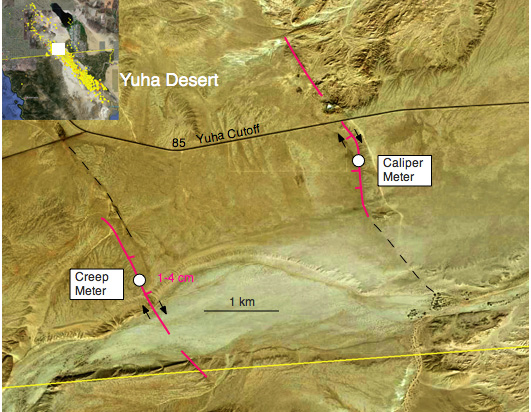Post seismic slip?
A search for afterslip in the Imperial Valley and Yuha desert (7-11 April) following the 4 April mainshock has currently not revealed afterslip, except in the form of an additional 10% slip on the southern San Andreas fault in the two days following triggered slip. Reports are currently awaited from northern Baja where Ewa Glowaska (CICESE) is currently gathering creep data (12-13 April), and investigating future instrumentation locations.

Google earth view of US/Mexico Border (yellow) showing locations of two afterslip meters on mapped ruptures each with less than a few cm of slip.
Two creepmeters were installed 5 days after the earthquake on faults on which dextral slip of 1-4 cm was triggered by the earthquake - see figure above. A 4-5 km wide graben subsided a few mm between two mapped faults. We thank geologists from the USGS (Katherine Kendrick) and from the California Geological Survey (Janis Hernandez, Pamela Irvine and Jerome Treiman) for pointing us to theses locations

View NW of near vertical dextral fissure with the 32 mm outside diameter PVC pipe at base of 30 cm deep trench through which the creep-meter rod passes at the above Caliper meter site (photo 10 April 2010). Vertical offset here exceeded 8 mm in some locations (Down to the west).
Despite ongoing aftershock activity below this area (inset top left) no additional movement of these faults occurred 8-11 April). Data from the creep-meter are telemetered every 15 minutes show the fault is currently locked. The caliper meter has a dial gauge that must be read manually.
The "Border" creepmeter may be accessed at www.datagarrison.com (user geo) (password hobo)

The caliper is bolted to one side of the fault and its depth-probe to the other via a 7-m-long graphite rod. The mounts consist of meter-long steel square section tube driven at 45 degrees to refusal and bolted together at the attachment point of the sensor. In the creepmeter, the caliper is replaced with an LVDT that samples displacement. A temperature reading is recorded along with displacement every 15 minutes.

The border-line fault creepmeter is accessed via a buried irrigation cover box which contains transducer and data logger whose internal batteries power the system for18 months.
